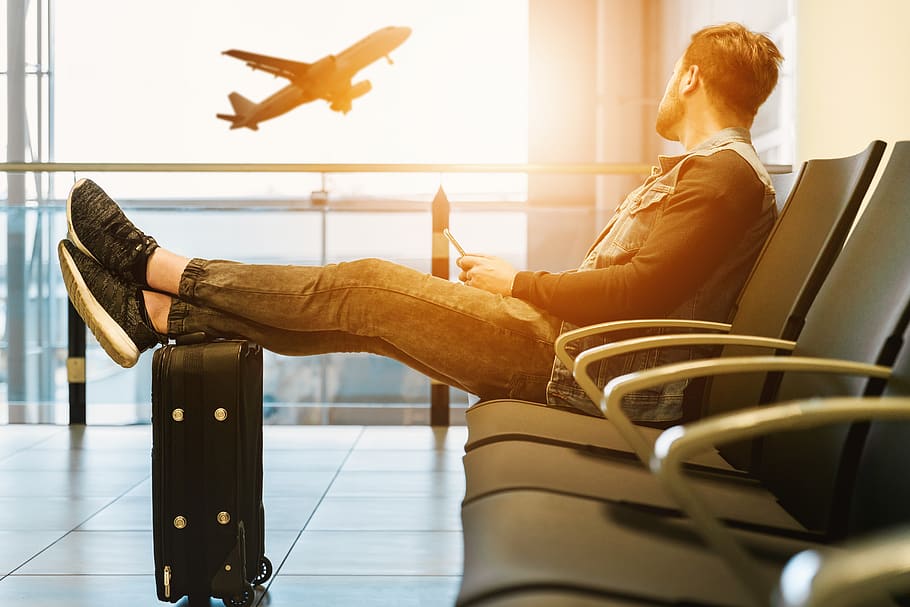
Most of us love traveling either for work or leisure. However, there are risks and certain health conditions associated with airline travel. Compression socks for travel can help alleviate these conditions as they help blood circulate from the feet throughout the rest of the body.
Between sitting down for hours on end, the change in climate and cramped conditions, traveling can be tough on your body. Stiff muscles, dehydration, and fatigue are not the only hazards you can experience when traveling. You could develop deep vein thrombosis (DVT) or leg swelling. Packing compression hosiery reduces the risks of swelling, blood clots, and similar health problems.
It is always important that you choose the right compression hosiery whenever traveling but be aware that wearing these socks at the wrong time could mean they aren’t as effective as you need them to be. Travelers are always advised to put on these socks before they actually begin traveling to minimize the risk of developing varicose veins, DVT or leg swelling from traveling.
It’s recommended that you wear the socks early in the morning ideally, as soon as you wake up since the legs haven’t yet had time to swell. This allows the legs to adapt to the compression stockings and also reduce the risk of swelling later on when traveling.
What Are Compression Tights?
Compression stockings are fitted socks that offer support up to the top of your calf. These stockings encourage optimal blood circulation from your ankles to your heart. Compression stockings apply more pressure at the ankles and reduce the pressure toward the higher points of the leg.
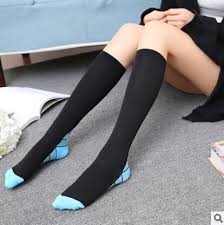
They work by applying constant pressure to prevent pooling of blood in the legs which is what contributes to the development of blood clots. To understand how compression stockings work, you should understand the biology of the human body. Arteries bring oxygenated blood from the heart to all areas of the body and the veins return the blood to the lungs for fresh oxygen, thus the compression stockings work by aiding the venous return.
Types of Compression Hosiery
Before you can pack for the journey, you should first understand types of compression stockings. These are medical-grade stockings designed to help in the movement of the blood. These socks come in different compression strengths that include mild (8-15 mmHg), medium (15-20 mmHg), firm (20-30 mmHg) and extra-firm (30-40 mmHg).
The pressure is measured in mmHg (millimeters of mercury). You will find two numbers associated with these socks and they represent the pressure measured at the ankle and the calf. For example, a 15-20 mmHg means 15 mmHg of pressure at the calf and 20 mmHg of pressure at the ankle. The lower the number, the milder the compression.
For travelers without a medical condition, it’s possible to start with the lower compression stockings, as they are easy to put on. Stockings with higher pressure are designed for people who have advanced symptoms ranging from venous surgery to leg swelling. Some higher compression stockings require a prescription.
Here are three primary types of compression socks on the market:
- Graduated compression socks
- Non-medical support socks
- Anti-embolism socks
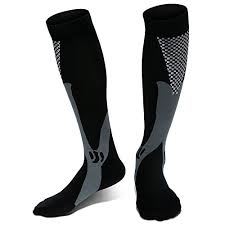
Popular Articles on ComproGear
Best Compression Socks for Sitting All Day Compression Socks for Work
Graduated Stockings
With graduated stockings, the pressure level is strongest at the ankle and gradually decreases as you move up the leg. They are designed to provide not only compression but also allow for mobility. They generally require professional fitting. Stockings that end below the knee helps limit peripheral edema or leg swelling that occurs as a result of fluid buildup.
There are compression hose variants that extend to the thigh or waist to reduce pooling of blood in legs thus preventing orthostatic hypotension. Some compression hosiery suppliers are designed to appeal to personal preferences, such as being open or closed-toe or colored options.
Non-Medical Support Socks
These socks do not need a doctor’s prescription. They include flight stockings that offer elastic support as a potential relief for aching legs. You can purchase these socks online or at your local pharmacy.
Anti-Embolism Socks (TED stockings)
These support socks reduce the likelihood of deep vein thrombosis. Just like the graduated socks, they offer gradient compression but the level of compression differs. These types of socks are designed for those who are immobile.
Who Should Wear Compression Stockings?
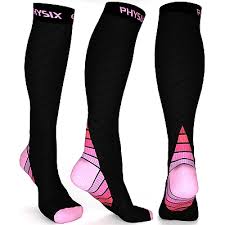
Apart from people who stand for long periods due to the nature of their jobs or have medical conditions, travelers can also benefit from the use of compression support stockings. Those at a high risk of blood clots and swelling, such as obese people, pregnant women, those with clotting problems, individuals with varicose veins or someone who’s had blood clots in the past can benefit from compression stockings. If your condition is severe, you should seek advice or a prescription from your healthcare provider.
Due to the long hours involved when traveling, compression hosiery will help your blood circulate due to the pressure applied to the ankles and calf. This will reduce the chances of developing blood clots or swelling.
If you fall into any of the following categories, you could potentially benefit from the use of compression stockings, particularly when traveling.
- Have cancer
- Have a history of pulmonary embolism
- Have had a stroke in the past
- Have heart disease
- Tend to get blood clots
- Have undergone surgery recently especially in the legs
- Are obese
- You are pregnant or have had a baby in the previous 6 weeks
- Taking estrogen-containing medicines.
Take extra precaution by wearing support stockings during the journey. If you suspect you are at risk of developing deep vein thrombosis, you can seek help from your health provider before traveling.
Who Should Avoid Support Stockings?
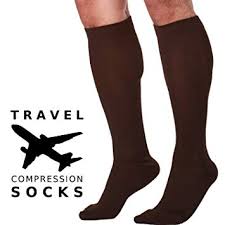
While most travelers wear support stockings without any major side effects, they might not be suitable for those with certain medical conditions. Compression stockings can be uncomfortable for people with open wounds on the legs or patients with severe peripheral arterial disease.
Those with poor circulation, damage to the nerves in the feet from diseases such as diabetes or otherwise, and skin infections should first seek a doctor’s prescription as flight stockings might not be ideal for them.
Avoiding Deep Vein Thrombosis (DVT) When Traveling
Travel-related DVT is rare in healthy people but when traveling for long distances, there are several ways in which you can minimize the risk of developing DVT.
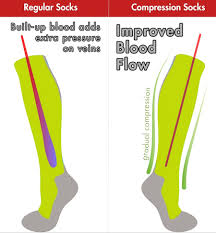
DVT is a condition where a blood clot forms in the deep veins usually in the leg which in turn results in blocked veins, hindering blood flow. This condition can occur after sitting still for long periods when traveling in the air, train or bus.
Minimizing the Risk of DVT When Traveling.
If your journey involves traveling for three or more hours by train, car or plane, consider the following steps during the journey to minimize the risk of developing DVT.
- Wear loose comfortable clothes
- Hydrate while on the journey
- Avoid using alcohol or sleeping pills
- Whenever you get the chance – walk around
- Do calf excises at least every 30 min. You can do this by raising your heels, keeping your toes on the floor then bringing them down 10 times. Then raise and lower your toes 10 times.
Traveling When Recovering from Deep Vein Thrombosis
If you are recovering from previous DVT, you are probably taking medication to prevent new blood clots. If this is the case, the medicine will help reduce the chances of developing another DVT. If you’re on medication, the risk of developing DVT from traveling is lower and there should be no reason why you cannot travel. Speak to your healthcare provider before traveling if you have any concerns.
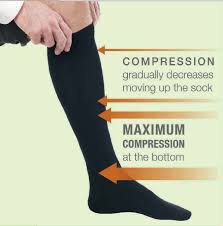
Choosing Compression Stockings
There are different varieties of compression stockings on the market and they vary in compression level, length, material, style, and size. It can be overwhelming and confusing when trying to choose your support stockings. These are the factors that will guide you when searching for compression socks. If you are wearing compression stockings due to a medical condition, speak with your doctor about the best option for your needs.
Compression Strength
The compression level you need will depend on your needs. The standard levels include:
- Light-moderate compression, 15-20 mmHg – these are perfect for traveling. If your work involves standing all day, you are pregnant or experiencing mild leg swelling, these socks will also come in handy.
- Moderate compression, 20-30 mmHg – these are excellent for moderate swelling and varicose veins because of pregnancy or another condition. You can also wear them when your legs feel tired and heavy.
- Firm compression, 30-40 mmHg – these support socks are usually required when you have moderate to severe varicose veins, moderate edema, or after vein treatment such as vein stripping. They also come in handy for combating lymphedema.
- Extra firm compression, 40-50 mmHg – they help with severe edema, or varicose veins, chronic venous diseases or severe post-thrombotic syndrome.
- Heavy compression, 50-60 mmHg – this sock level is the strongest standard compression level and is primarily used in relieving Post Thrombotic Syndrome and lymphedema.
Material
Some socks are made of rubber, Lycra or spandex and they come in different lengths like knee, thigh or full. If your need for compression socks is because you are traveling for a long period, then you need to choose a sock that is comfortable for you.

Size
You need to find the right support size when selecting these stockings. Retailers help by providing a measurement chart that will instruct you on how to best decide your size. These charts depend on what type of compression hose you desire. For example, your shoe size will greatly influence a knee sock or over the knee sock. Full compression socks usually come standard sizes in department stores. The size of your support stocking is based on a ratio between weight and height. Others may require measurements for ankle circumference, calf-length, and calf circumference.
Style
Most people opt for a style that’s not very noticeable and looks like ordinary socks or stockings. Retailers will give you an option from which you can choose. You can choose from a blend of colors to plain colors, depending on your desire and use. You can also choose between closed or open-toe support socks.
Wearing Support Stockings When Traveling
It takes a little practice to put on compression hosiery. The best way to wear them is to grab the toe and fold the rest of the socks inside out. Afterward, place your foot into the toe area and roll the rest of the socks over your ankle and calf.
It is recommended that you put on the support stockings in the morning after waking up as this is the time before your leg develops any swelling. Otherwise, it’s unlikely you’d be able to put the stockings on while you’re already traveling.
Remember that if you feel discomfort while wearing the compression socks when flying, then you have the wrong compression strength. This can cause more harm than good. Wearing compression stockings should feel firm around your calves but not painful or uncomfortable.

Benefits of Support Socks While Traveling
Compression stockings offer various benefits to users. They apply pressure to the ankles and calves to reduce swelling and DVT when traveling. The pressure helps improve blood flow in your legs and as it moves back to your heart.
Comfort
Sitting for long periods might expose you to the risk of developing DVT. The lack of mobility causes low blood flow and puts a traveler at risk of dangerous blood clots. This is why you should rely on compression stockings to have a pain-free journey.
Speedy Injury Recovery
Doctors recommend using support socks to naturally stimulate the healing of the body. Compression socks are effective after a patient has undergone surgery and when managing chronic illnesses and pain. Be sure to consult your healthcare provider as compression stockings are not recommended for some medical conditions.
Maternity Relief
Pregnant women find immediate relief from aching and swollen legs when they use compression hosiery. The support socks and sleeves offer a comfortable, cooling effect and are easy to put on.
Improved Productivity
Employees who work standing up for long periods can decrease the chance of getting swollen feet by using Compression stockings. The support socks will invigorate the feet and legs by alleviating muscle stiffness caused by the lack of movement.
Improved Athletic Performance
Some athletes claim that support stockings help improve their performance. Wearing compression hosiery during and following workouts will improve muscle recovery. Support stockings naturally prevent lactic acid from building up and reduce wear and tear on the muscles.

Conclusion
Compression stockings are a great way to reduce swelling of the feet when traveling. You should first find out the best compression strength for you before wearing any compression stocking. This will enable you to have all the benefits of the support socks without the risk of developing further medical conditions. Wearing the wrong compression level is counterproductive. Don’t forget to pack these support stockings whenever traveling, for a comfortable journey.
This page last updated December 15, 2022
